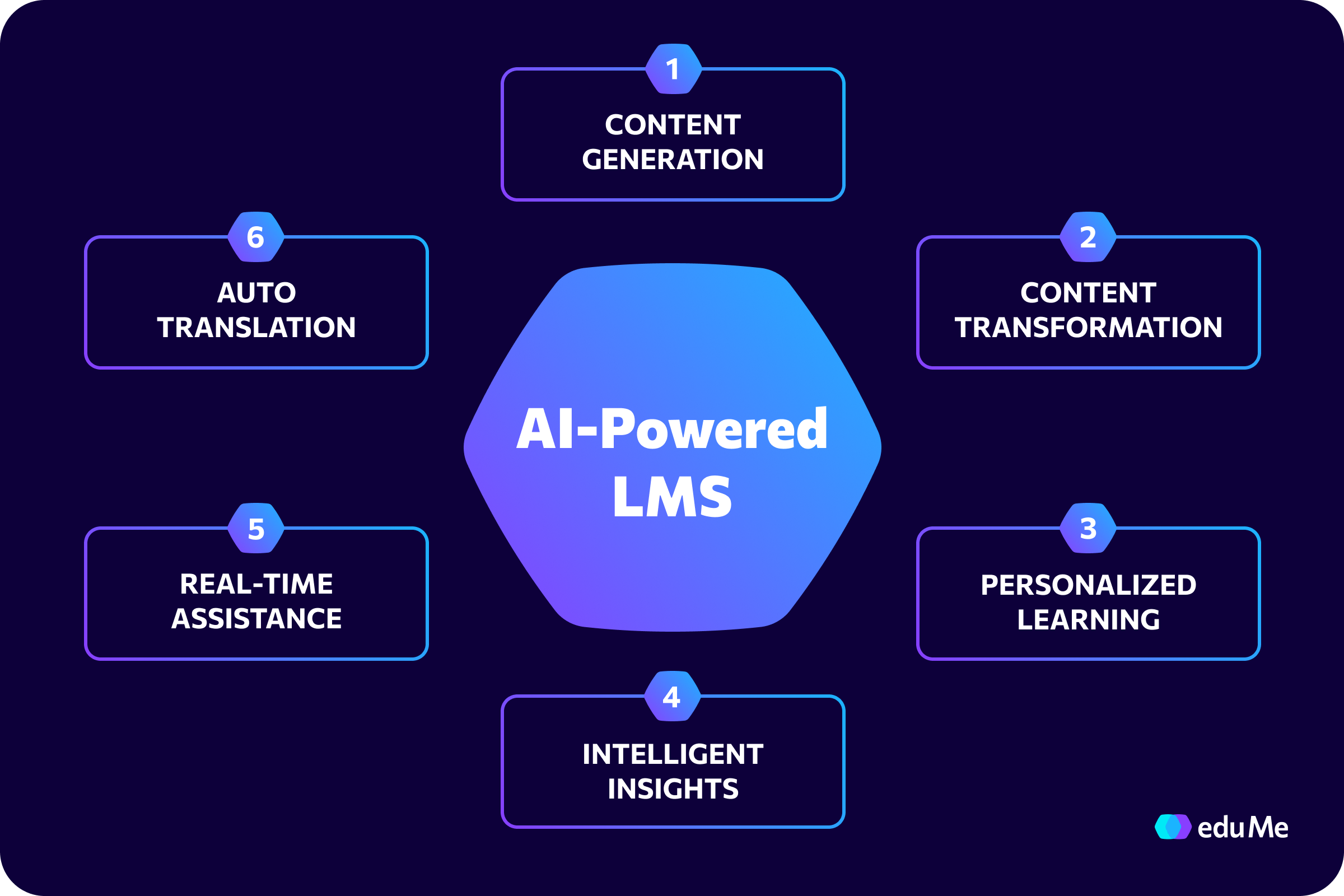Choosing the right training tool for your business can be a daunting task. With so many options on the market, all promising to transform the way you train and upskill your workers, it can be difficult to cut through the noise.
Now, with the advent of artificial intelligence (AI), the software selection process has become both more complex, and more rewarding. By successfully harnessing the power of AI within their training program, L&D professionals can gain access to an array of intelligent features with the potential to enhance training effectiveness, personalize learning experiences and supercharge the content creation process.
However, with an increasing number of LMS providers incorporating AI capabilities and the rapid pace of AI evolution, it’s crucial to be aware of which features will actually bring value to your organization.
In this article, we’ll guide you through the intricate world of AI-powered LMS’ and highlight six crucial features you should look out for.
|
Jump to 🔍 |

1. Content generation
Your challenge
If you’re responsible for creating training content for your learners, you’ll be very familiar with the struggle of simply getting started. When inspiration fails to strike, delays in creating content can quickly turn into productivity bottlenecks which impact your ability to get information out in a timely manner.
AI's solution
AI-powered instant lesson generation gets the ball rolling on content creation by providing a foundation from which to build your lesson. Simply by entering a few prompts - such as who your learners are, and what you want to teach them - you can use AI to generate a fully fledged template complete with learning outcomes and even quiz questions to test knowledge retention.
We know what you’re thinking, will the content it generates actually be usable? The difference between these specially designed LMS features and tools like ChatGPT is that they’ve been programmed with learning best practices. eduMe AI, for example, was created with the help of our in-house Learning Consultancy team to ensure that every lesson you create is optimized for knowledge retention.
Opting for an LMS with AI content generation won’t completely replace your content creation process. It just means you won’t have to start from scratch any time you want to create training on a new topic, reducing your workload and giving you more time to focus on refining the details.
2. Content transformation
Your challenge
You’ve built up a whole library of existing training resources over the years - from SCORM slides to training PDFs - but are now finding yourself tasked with putting this old content into a new, perhaps digital, format for your workforce.
Converting long form content into bitesize microlearning can be a painstaking process, requiring significant time and resources to comb through hundreds of pages and summarize the most important information - time and resources which would be better spent elsewhere.
AI's solution
Luckily, AI offers a much faster solution. Existing content can now be uploaded and instantly transformed into engaging microlearning lessons, with features that automatically identify key information and apply best practice to generate a lesson. Pulling information from your own resources also means that you’re able to create lessons that are relevant and personalized to your business, avoiding the pitfalls of generic, AI-generated content.
For example, you could upload your restaurant’s updated wine list and use the AI feature to instantly create a lesson to get your wait staff up to speed. Or, you could input your employee handbook to assist you in creating an onboarding course for new store employees.
No matter which industry you operate in, AI-powered content transformation features spare content creators the burden of manual content restructuring, and instead enable them to deliver training content that aligns with the learning preferences and attention spans of today’s frontline workforce, all in a matter of clicks.
3. Personalized learning
Your challenge
You want to create more personalized experiences for your learners, but don’t have the capacity to sift through data and manually set up automations. As a result, you’re left relying on one-size-fits-all training that fails to engage and lowers your training ROI.
AI's solution
With AI, you can automate the personalization of your training program within your LMS. Integrated AI algorithms can analyze learner data to create clever content recommendations based on employees’ specific role, region, or even past learning behavior.
Plus, algorithms can also recommend content designed to help them develop specific skills and progress further in their roles. If one of your store employees has expressed an interest in progressing to a management position, for example, they can be recommended additional courses on leadership development to help them on their way.
Having an LMS which automates these processes for you ensures that workers gain more value from their training, and gives your L&D team the tools they need to create high impact training without sacrificing productivity.
4. Intelligent insights
Your challenge
Reporting on learning data is a manual, laborious process which means that it often gets overlooked. As a result, you have poor visibility of how your training is actually performing and are unable to consistently iterate and optimize (the foundation of an effective training strategy).
AI's solution
One of the most powerful applications of AI in learning and development is its ability to process large amounts of data. LMS’ which leverage AI for their reporting capabilities give you instant access to the most important insights across your organization.
AI can help you spend less time trawling through data and more time getting to know your learners, surfacing relevant insights on how training is performing and recommendations for how to improve. For example, highlighting an assessment where a significant proportion of learners are getting the answer wrong, or identifying where the majority of learners drop off in a course and recommending an ideal lesson length for optimized completion rates.
With less time spent on spreadsheets and more time spent looking at the bigger picture, AI analytics put you in a better position to generate real business results from your training.
5. Real-time assistance
Your challenge
With such a large and widely distributed workforce, it’s near impossible to answer every support query from your learners in a timely manner. As a result, your team must scramble to balance support on top of their many other priorities, and your learners are left feeling isolated and unsupported.
AI's solution
The integration of AI-powered chatbots into LMS solutions has reduced the burden on L&D teams, providing 24/7 support to learners at every stage of their user journey. These automated chatbots act as helpful, friendly assistants, using existing company data - such as employee handbooks, company policies and even individual progression data - to answer questions in real time and serve up relevant information in an instant.
Better yet, chatbots and AI assistants also give you valuable insights into the common challenges your learners are facing, providing qualitative feedback on your training program without having to dedicate additional resources.
6. Auto-translation
Your challenge
You’re tasked with training a diverse deskless workforce spread across multiple regions. To ensure that your content is accessible in a number of languages, you often have to rely on freelance translators which is not only costly, but also hinders your ability to deliver learning at scale.
AI's solution
Instant translation of content isn’t new (Google Translate anyone?) but instead of translating text word-for-word like traditional machine translation, AI is able to better detect subtle differences in meaning. In other words, it’s much more similar to how a human would translate.
Employing AI-powered translation features within your LMS also aids content localization. When delivering courses to a number of different regions, it’s important to adjust for cultural context as well as language. Using AI ensures that content translations also take into account the learners’ region and specific context, resulting in a more personalized, engaging and therefore more effective learning experience.
While it’s recommended to have a human translator complete quality assurance checks and make sure that any content you send out is linguistically correct (and culturally sensitive!), using AI translation within your LMS can go a long way in scaling your translation and localization processes.
Get started with AI
Are you looking for an LMS which harnesses the power of AI?
eduMe is the training platform of choice for frontline workforces, helping you to deliver high impact training at scale. Our AI-powered tools make it easier, faster and simpler to create quality content and better understand your learners, driving a higher return on your investment.
Try creating your own lesson with eduMe AI 👇







